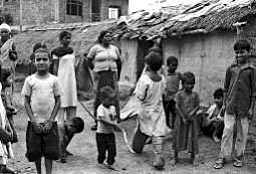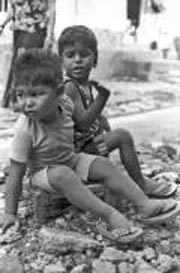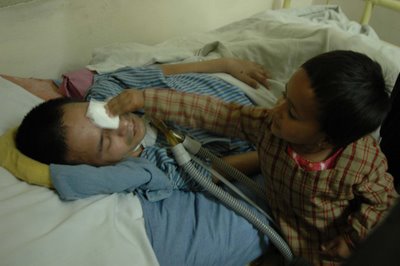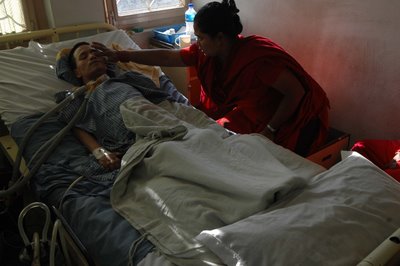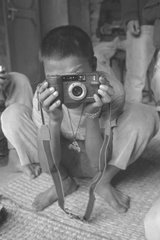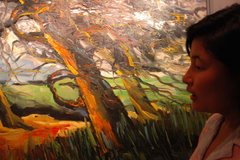Nisha Sharma as nun Purnima in Agniko Katha during the performence at Dreams Garden in Kathmandu on 17 OCt 2006.© Deependra Bajracharya
Girls on a rampage in "Agni Ko Katha"
My experience of watching "Agni Ko Katha" (A story of fire) in Gurukul proved to be romantically thrilling and hilariously exhilarating. Of all the scenes, one scene was particularly striking.Gyan, a seeker of truth and knowledge comes back to his village, perhaps his birthplace. He comes to his village because the library in his first monastery is consumed by fire. In the village, there is a small monastery. He goes there. As soon as he reaches the monastery, a bevy of three beautiful girls come. They find him very handsome. One of the girls tickles him, the other titillates him, and the last girl starts rummaging his bag. One of the girls even lifts the long yellow gown of the monk. It looks as if they are going to molest him romantically. Those girls become wildly fond of him. It seems as if those girls are enchantresses, bent on ruining the monk.
How long can the monk resist? As these flirtations reach a crescendo, the monk runs for his life. Once the monk disappears, those girls run around the monastery like deer, begin to giggle, and walk and capture the monastery with the weapon of laughter, giggles, nimble-footed walk and agile movements. It looks as if a monastery is the best place for the consummation of romantic impulse.
This highly sensual and humorous scene in Agni Ko Katha arrested my analytical attention. What did the dramatist Prof. Subedi want to imply by using this scene of sensuality and humour? In addition to this scene, there is another scene in which actress Purnima weeps and wails because Gyan is leaving the first monastery. The pain Purnima endures at the time of Gyan’s separation suggests a high degree of emotional attachment.I believe that by using these scenes of sensuality, perhaps the dramatist wanted to show materialistic elements within Buddhism. The route to salvation and enlightenment is not renunciation only, but aesthetic awareness also. Perhaps, Prof. Subedi subtly wanted to highlight this truth.
Finally, I would like to discuss one eloquent issue. What is Buddhism’s stand on femininity? There is no clear answer. But it is quite certain that there is no idea of gender in the pure creed of Buddhism. Where Gyan’s (a monk) journey for truth ends, Purnima’s (a nun) journey begins. Ultimately Purnima says "I love humanity. I leave the monastery and mix in this world for the emancipation of humanity." Here, I can’t help citing what Prof. Dor Bahadur Bista said regarding Buddhism - "Buddhism is the highest expression of Asiatic humanism, which ultimately brought the world on the threshold of a new civilization." Perhaps, this too is the message that Prof. Dr. Abhi Subedi wanted to give through Agni Ko Katha.
-Shiva Hari Mainali


